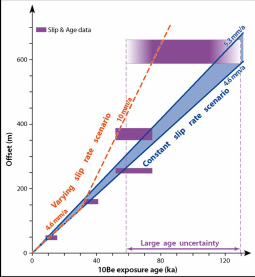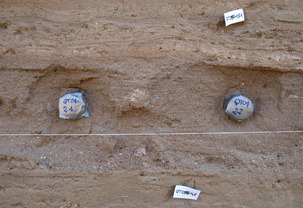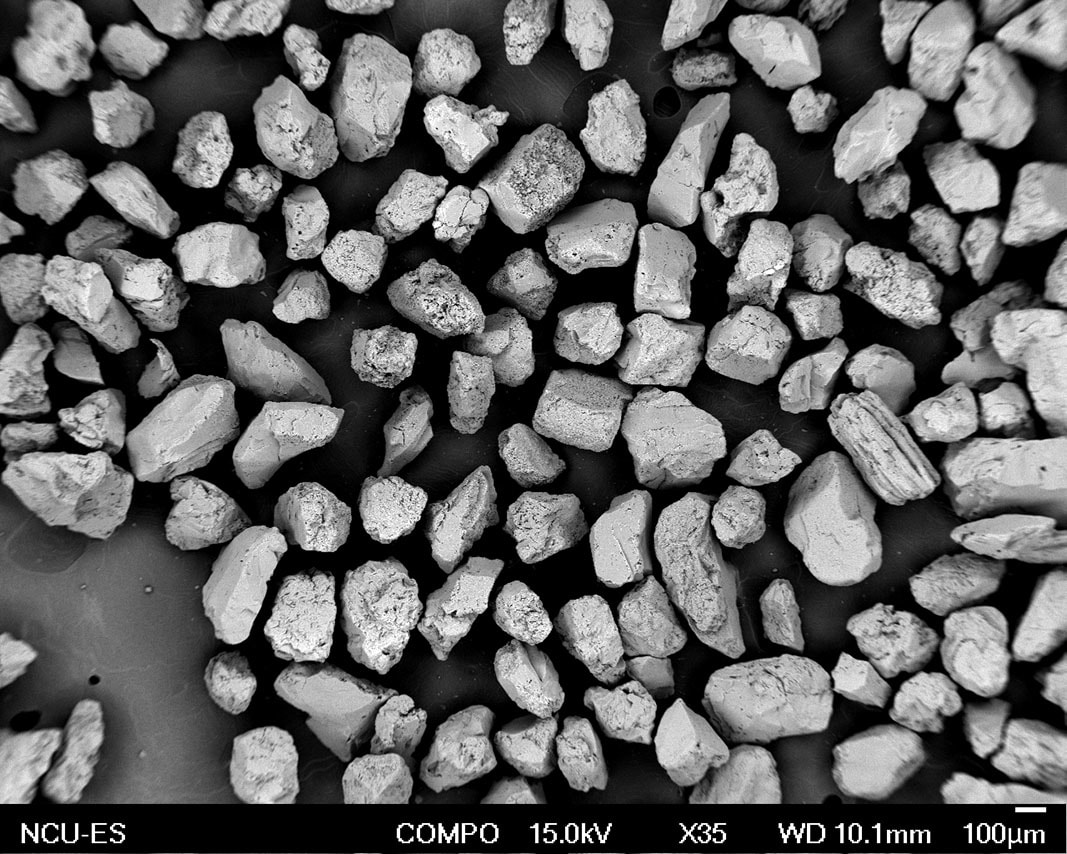Quaternary Geochronology > Dating the same sediment using different chronometers
|
Motivation and approach
Neo-tectonics studies are often limited by uncertainties due to difficulties in dating markers of deformation or by the lack of datable material. My experience on the Dead Sea fault raised 2 examples of such situations: the large uncertainty on the age of an offset alluvial fan that prevented us from assuredly discriminate between 2 tectonic scenarii (see Fig. 1) and the dearth of organic matter in a paleo-seismologic trench in Lebanon.
To overcome such difficulty, I learnt another dating technique, OSL, and I adopted a simple approach: dating the same sediment using different chronometers. Potential complexities in erosion, transport and deposition processes can bias quaternary geochronology techniques. However, bias will be different from one technique to the other. Therefore, my purpose not only is to obtain solid ages associated to smaller uncertainties, but also to try to understand (and hopefully quantify) the processes that led to a wrong age or to data scattering. On-going research projects
- 10Be, OSL and 14C dating of offset alluvial fans along the S. Dead Sea Fault: |
Large uncertainty associated to the oldest offset fan does not allow to discriminate between constant fault slip rate scenario (blue) and varying fault slip rate scenario (orange).
[modified from Le Beon et al, 2010, JGR] |
|
Age uncertainty of an alluvial fan dated ~90 ± 30 ka using 10Be cosmogenic nuclide prevented us from assuredly conclude on a constant slip rate over time for the southern Dead Sea fault (see GPS vs Long-term slip rate on the S. Dead Sea Fault). The offset fans were sampled for complementary dating using OSL on both quartz and feldspar minerals, and using 14C when possible. At every sampling location, OSL quartz ages are much younger than 10Be ages and would imply inconsistently fast fault slip rate. IRSL at 50˚C on feldspars indicated rates of signal loss (fading) that are beyond acceptable range. Eventually, preliminary analyses using a new method, post-IR IRSL at 290˚C, give promising results and will hopefully allow us to conclude regarding the kinematic behavior of the Wadi Araba fault. Age underestimation from quartz is likely due to saturation of the minerals.
|
|
- OSL versus 14C dates in a paleo-seismologic trench across the S. Dead Sea Fault: We aim at comparing OSL and 14C ages from a 3-m deep paleo-seismologic trench. The 14C chronology covers the last 5 ka. It was established using about 30 charcoal samples. Most of them are in stratigraphic order, which gives confidence in age accuracy. Paleo-dose analyses on a first series of 4 OSL samples are on-going. << OSL and 14C samples on the trench wall |
|
- OSL versus 10Be exposure dating of a set of tilted terraces on the Pakuashan anticline, central western Taiwan:
Earlier studies at Pakuashan (Simoes et al, 2007; Siame et al, 2012) lead OSL and exposure ages that are one-order-magnitude different, with the OSL quartz ages lightly constrained by <10 aliquots. After the numerous technical developments in luminescence dating during the last decade, we aim at dating the Pakua terraces again, using multiple luminescence techniques on quartz and K-feldspar and using 10Be depth profiles, if the outcrop allows. Back-scattered electron microscopy of the etched quartz from terrace PK4 >> Homogeneous gray-scale shows homogeneous chemical composition, later determined to be SiO2 by EDX (energy-dispersive X-ray) |
>> References:
Poujol, A., M. Le Béon, A. Kunz, L. Siame, L.-W. Kuo, R.-F. Chen, W.-J. Huang and Y.-G. Chen, Luminescence ages from quartz and feldspar (post-IR IRSL) and 10Be exposure ages of Late Pleistocene terrace deposits at the deformation front of central Taiwan, 5th Asia-Pacific Luminescence and Electron-spin-resonance Dating conference, Beijing, China, October 15-17 2018, Abstract
Poujol, A., M. Le Béon, L. Siame, A. Kunz, R.-F. Chen, W.-J. Huang and Y.-G. Chen, New chronological insights from Late Pleistocene tilted terraces along the deformation front of the Central Range (Taiwan): A comparison of luminescence and in situ cosmogenic dating, EGU2018-1178, EGU General Assembly, Vienna, Austria, April 8-13 2018, Abstract.
Le Béon, M., M. Jaiswal, A. Kunz, M. Al-Qaryouti, G. Burr, Y. Klinger, K. Moumani, Y.-G. Chen, H.-C. Li, M. Abdelghafoor, and J. Suppe, Slip rate determination along the Southern Dead Sea fault: optically stimulated luminescence, 10Be cosmogenic radionuclide, and 14C ages brought face to face, XIX INQUA Congress, Nagoya, Japan, July 27 - August 2 2015, Abstract.
Le Béon M., M. Jaiswal, Y.-L. Chen, M. Al-Qaryouti, A. Kunz, Y. Klinger, G. Burr, K. Moumani, Y.-G. Chen, M. Abdelghafoor, J. Suppe, Slip rate determination and paleo-earthquakes dating along the Southern Dead Sea fault: optically stimulated luminescence, 10Be cosmogenic radionuclide, and 14C ages brought face to face, Tectonics of the Levant Fault and the Northern Red Sea, Paris, France, July 8-9 2013, Abstract.
Poujol, A., M. Le Béon, A. Kunz, L. Siame, L.-W. Kuo, R.-F. Chen, W.-J. Huang and Y.-G. Chen, Luminescence ages from quartz and feldspar (post-IR IRSL) and 10Be exposure ages of Late Pleistocene terrace deposits at the deformation front of central Taiwan, 5th Asia-Pacific Luminescence and Electron-spin-resonance Dating conference, Beijing, China, October 15-17 2018, Abstract
Poujol, A., M. Le Béon, L. Siame, A. Kunz, R.-F. Chen, W.-J. Huang and Y.-G. Chen, New chronological insights from Late Pleistocene tilted terraces along the deformation front of the Central Range (Taiwan): A comparison of luminescence and in situ cosmogenic dating, EGU2018-1178, EGU General Assembly, Vienna, Austria, April 8-13 2018, Abstract.
Le Béon, M., M. Jaiswal, A. Kunz, M. Al-Qaryouti, G. Burr, Y. Klinger, K. Moumani, Y.-G. Chen, H.-C. Li, M. Abdelghafoor, and J. Suppe, Slip rate determination along the Southern Dead Sea fault: optically stimulated luminescence, 10Be cosmogenic radionuclide, and 14C ages brought face to face, XIX INQUA Congress, Nagoya, Japan, July 27 - August 2 2015, Abstract.
Le Béon M., M. Jaiswal, Y.-L. Chen, M. Al-Qaryouti, A. Kunz, Y. Klinger, G. Burr, K. Moumani, Y.-G. Chen, M. Abdelghafoor, J. Suppe, Slip rate determination and paleo-earthquakes dating along the Southern Dead Sea fault: optically stimulated luminescence, 10Be cosmogenic radionuclide, and 14C ages brought face to face, Tectonics of the Levant Fault and the Northern Red Sea, Paris, France, July 8-9 2013, Abstract.




